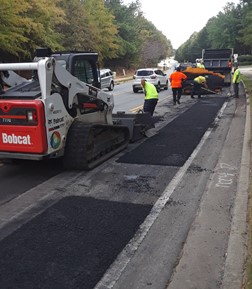Resurfacing
Breadcrumb
Page Content Portlet
Street Resurfacing Information
The Gwinnett Department of Transportation resurfaces streets on an as-needed basis. This is funded by the Special Purpose Local Option Sales Tax, known as SPLOST, and state funds. The lists below include roads that will be resurfaced during the respective year:
Each year, Transportation staff rate the pavement conditions of roadways throughout the county. Streets that receive a rating of 55 or below on a scale of 100 are prioritized for resurfacing. Streets above that level are patched as needed and reexamined in the following years.
Asphalt is used in road construction. It is one of the most durable paving materials, but it is also flexible and can cause cracks in new pavement. The commonly used pavement maintenance techniques and typical steps in resurfacing our roadways are below.
Step 1: Crack seal
Crack seal is a line or split on the surface ranging from simple, minor imperfections that are 1/8 inch to 1/2 inch wide to large cracks that involve the base. To limit depreciation, pavement cracks are filled with tar to assist in the prevention of pavement failures and potholes.
| Before | After |
|---|---|
 |
 |
Step 2: Asphalt milling (pavement milling)
Asphalt milling (pavement milling) is when the surface layer of damaged asphalt is removed to repair internal structural damages in the roadway. Asphalt milling helps prevent pavement damages such as rutting, gradient defects, and uneven pavement.

Step 3: Asphalt patching
Asphalt patching is the process of filling potholes or hollow areas in the asphalt pavement. Quick repair of potholes or other pavement decomposition helps control further depreciation and repairs.

Step 4: Asphalt resurfacing (asphalt overlay)
Asphalt resurfacing (asphalt overlay) is the application of new asphalt over the top of an existing pavement. This usually adds one to two inches of asphalt and corrects structural damage. This allows the contractor to keep sewer access covers, curb reveals, and transitions at their original height. Resurfacing contractors begin their work in the spring and work to complete all the resurfacing by November, weather permitting.
Final topping typically occurs up to 30 days after the milling and patching process, weather permitting.
 |
 |
Step 5: Roadway striping (as needed)
Roadway striping ensures that the road is as safe as possible based on its speed limit, traffic volume, and line-of-sight issues like curves and hills. Roadway striping is not performed on residential streets.

Step 6: Adjusting manhole lids (as needed)
Adjusting manhole lids can apply to a specific roadway. There may be existing utilities located within the pavement. Typically, the contractor will pave over these utilities and then return 15 to 30 days later, weather permitting, to adjust utilities to the new pavement height. This process involves concrete and can occur the middle of the roadway.
Step 7: Shoulder work (as needed)
Shoulder work depends on the surface character of the area where the maintenance and repair are performed. The shoulder is a strip of pavement outside an outer lane provided for emergency use and to protect the pavement edges from traffic damage.
Shoulders require very little maintenance but can create a serious accident hazard. This can be corrected by reconstruction, resurfacing, or other appropriate measures. Due to continuous wetting and drying of shoulder, edge joints between the lane and shoulder can cause settlement of pavement due to water entering the subgrade soil. This can be repaired by filling the joint with sand and asphalt concrete.

Step 8: Cleanup
Cleanup is a vital step towards usable asphalt street resurfacing. Contractors will remove any debris and old asphalt from the area. Old asphalt must be sent for recycling, a process known as reclamation. Reclamation is another way to keep the costs of asphalt installation down. Cleanup is a process that happens before, during, or after completion of the entire resurfacing process.

Step 9: Punch list
Punch list is a document showing work that still needs to be done on a specific street. It is an important component of the post-construction phase. Once the physical resurfacing has been completed, the construction manager and/or engineer will do a walkthrough of the project and note any changes that need to be made.

To report issues on roadways within Gwinnett County, contact Gwinnett Transportation at 770.822.7474.
